On The Brink – An Interview With Paul Wedgwood
by Iain
Eurogamer Expo was a bit of a mixed bag for me in terms of games. Some of the games I’ve been looking forward to such as Gran Turismo 5 seemed to be a little bit of a letdown and others that I initially thought looked terrible like Dance Central turned out to be pretty impressive (although the hot dancers may have swayed it slightly). One game that lived up to all its expectations and more however was Brink, a first person shooter developed by Splash Damage – the company behind Wolfenstein: Enemy Territory and Quake Wars: Enemy Territory. While I was at Eurogamer I had the pleasure of interviewing CEO of Splash damage, Paul Wedgwood about excuses to shoot guns, the PR guy from The Apprentice and the intuitive SMART (Smooth Movement Across Random Terrain) system.
Starting off with a bit of background about Splash Damage, the company started life as a modding team, so how does it feel to make your own game, as opposed to creating mods for an existing title?
I think it feels exactly the same. When we first started out as a mod team, we had thirty, maybe thirty-five guys distributed around the world; all communicating via IRC in real time, working on art assets, level design, art design, animation and code. It was something that I was really passionate about. Obviously the scale of what we’re doing now has grown; we have eighty-odd staff in the studio, Splash Damage has become a globally recognised brand as a core shooter developer and I’m pretty proud of the success we’ve had with games like Wolfenstein: Enemy Territory and Quake Wars, but the way that we develop games which is to be really passionate about our games, put a lot of work in and try to make stuff shiny, is basically the same thing.
Do you feel that working on a new IP has given you more creativity than with previous games?
It’s certainly nice to create a universe from scratch; one of the great things about Brink is that because it takes place on this immense, artificial, floating city it is a world that players haven’t seen before. It hasn’t been a popular topic in television, games or movies so people don’t have any pre-set expectation of what they expect to see so it allows us to do things like our hyper-realism with our style where we have exaggerated colours and proportions and include the environment as a kind of third character in our narrative and also tell a story for the first time. Ed Stern, our lead writer, has been with us since day one at Splash Damage but when he started he was writing World War II scenarios for Wolfenstein, then he wrote in the Doom universe for our multiplayer maps and then it was the Quake scenarios for this bio-mechanical, augmented race, the Strogg invasion of Earth for Quake Wars, as a prequel to Quake. When I had the idea for a floating city, that’s really all it was but Ed ran with that and wrote a forty year back story from 2013 when the city was constructed off the coast of San Francisco through a forty year period where it eventually loses contact with the rest of the Earth entirely and becomes the centre of conflict, which is at the end of the day an excuse to shoot guns.
A lot of the story seems to revolve around the idea of people running out of resources and struggling to survive on what’s left. Was that based on modern day scenarios such as the oil crisis we keep hearing about?
Well when I try and think of compelling reasons to shoot guns, end of the world scenarios are the most interesting. In Wolfenstein it was World War II, in Quake it was the Strogg invasion and in Brink it’s an artificial city that exists with the rest of the world entirely absent. If you ever do any research on the subject, there really are only about ten stories you can tell that lead to the eventual end of mankind. That’s why when you look at religion with things like rapture or ragnarok, every religion has this end of the world story, so if you’re looking at contemporary, believable reasons you’re kind of limited to people fighting each other, plague or alien invasion so what we try to do is come up with settings that are a bit different and something people haven’t seen in the past.
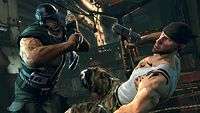 |
 |
 |
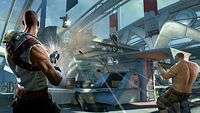 |
 |
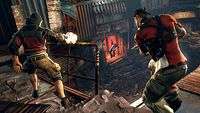 |
Moving on to the art style of Brink; you mentioned earlier about the hyper-realism; a cross between a caricature style and photorealism. Is that something you wanted in Brink from the outset?
It’s a real trick we play on people but no, not at all. I wanted a completely photorealistic game and that is what I fought for in the first year but the most important lesson I learned when becoming a CEO was in a book called “Good to Great” by Jim Collins. Actually, most business books are fairly boring, with pointless advice from academics who have no real sense of what’s going on in the industry but there was one great notion that you must get the right people on the bus before you figure out where you’re going to take it. While that doesn’t literally mean you don’t plan a route or have a sense of where you want to get to but you don’t have to define too many of the details – you can trust through delegation those responsibilities to people and know they’ll do a good job of it.
We hired a great art director, Olivier Leonardi, who was the art director for Prince of Persia and Rainbow Six: Vegas and when he joined us more than two years ago the first thing he said was “I want to put colour back in shooters” because it was just a sepia, desaturated nightmare and we were just as guilty as everyone else. He also said “This game should be hyper realistic, I want exaggerated proportions, I want to have everything colourful and really different” and because it’s a world that people haven’t seen before, it’s something we can do. As I said before, it’s not something that people have pre-set expectations of what it should be like so it allowed us to play a lot with those basic ideas. If we wanted to do something like Reactor, the level we showed at E3, well it’s very sparse and it’s only since people have seen Container City that they would know we can draw the level of detail that we did, but if we did a sparse, empty environment we did it on purpose, it’s not because the technology is limited.
A lot of the screenshots from other levels also seem to have a lot more colour than the other shooters that are around at the moment, was that the idea from the very start?
Yeah, I think that’s really been Olivier’s vision from the very beginning and it’s been very interesting because I fought so hard for photorealism. It’s not to say that I give up easily just because I delegate responsibility, I still argue the hell out of anything if I can, but I’ll defer to their opinion because that’s why we hired them in the first place. There’s a funny anecdote about it because we did some video diaries and I didn’t realise that later I’d written in a developer diary that I was wrong all along and that photorealism wasn’t the future and that art direction could have as big, if not bigger, impact on the visual interpretation of the game but it just seemed that visual, graphical representation seemed to be the bar the everyone was reaching for. “How many polygons can we push? What texture resolution can we use?” When I saw this coming together and got what Olivier was trying to do, I wrote this dev diary saying I was wrong all along and Steve Gaffney, our studio director, printed out on an A3 sheet of paper and stuck it on the back of Olivier’s computer. When the film crew came in, they recorded it so the first time I saw it was with the rest of the world; this big thing that just said “I was wrong all along” and I thought that was quite funny.
Moving on from the art direction now, Brink features a lot of customisation options. Was that something you felt strongly about?
Absolutely. The funny thing is that when I wrote the first concept, and it really wasn’t much more than a couple of pages which everybody else ran with and started developing from. I always wanted a character that was persistent; that I could modify and upgrade, although I didn’t think of the weapon modification system and I’ve always wanted a better movement system in a shooter but I’m not a level designer or an artist or a programmer. In all the games we’ve developed I’ve never ever made something that has gone in to the final game. I’ve always just had basic ideas and talked to the guys about how I wanted those implemented and then almost always, they think of a better idea than I had and implement it in a different way so it ends up being a much better system.
SMART’s a perfect example of that; I knew I wanted improved movement in a shooter but it’s only when talking to Richard Ham, the lead game designer on Fable II who then became our creative director, was it clear to me that it shouldn’t be a skill based system – that there was no sense in making people press A, then B, then X, then Y to clear something. You wouldn’t make someone press A, B, X, Y to climb up a staircase so why do it to climb on a table or a chair or climb over a wall. It makes no sense but I’d never thought about it like that so when he said the SMART button should be one button and not skill based I thought, “What? Are you mad? Why would you want to do it that way?” but it makes so much sense now because we hired Aubrey Hesselgren, who’s our technical designer on SMART, and he was a parkour enthusiast. He strapped a headcam to his head and recorded all kinds of footage and it became clear to me that this was a game that was about movement and simultaneous movement. This wasn’t a game where you move a bit and have a gunfight, then move a bit to the next fight so that meant it had to be procedural and we couldn’t use canned animations. If you’re halfway up a wall and you get shot at, you need to be able to turn round and shoot back so that’s how the system came to be what it is today.
With the SMART system were you ever worried that ‘hardcore’ gamers might prefer a skill based system?
No, not really because if we’d done it as a series of canned animations I think that would’ve been the case but we’ve got another great guy called Fabrice Bouvet, he’s our lead animator and has worked on games like Splinter Cell over the years. His team have worked really hard to disguise all the animation that’s going on under the hood. So when you’re running, there’s very subtle things like your hand slapping the surface of something as you vault across it or the way your gun reacts to the camera, or the way that Aubrey simulated what happens to your eyeballs in dampening as you come down on a hard surface, take off and start running again. There’s a million subtle things where the character artists, character animators and the level designers have created a system that feels like it was a breeze to implement and work with, but as Aubrey said in one of the developer diaries, when you’re working in a grey, blocky environment, everything’s fine but once you implement it in a world that’s more representative of real life such as container city, you no longer have railings and objects that are perfect heights so our system is procedural because it has to support objects that are any height or any angle and so on.
 |
 |
 |
 |
 |
 |
Also with the SMART system, the character’s height and weight affects how they move around the environment, how did that idea come about?
I couldn’t tell you who it was how had the idea of the three different body types but the general idea behind it was that not everybody wants to be crazy parkour guy who does wall jumps and gets to really high locations. Some people just want to run and gun or play defence and playing defence in particular, having lots of extraordinary parkour moves isn’t going to be particularly useful. This isn’t about free running where you’re doing backflips and somersaults, this is just about freedom of movement so we devised three body types; there’s a skinny body type and he can run faster, jump higher and slide at a higher velocity but he only has limited access to weapons, like pistols and sub-machine guns. Then we have the medium build who can do most of what you need to do like vaults, slides and mantles but can use assault rifles and shotguns as well and finally we have the big body build, who is this thundering guy. I would say he’s not like a body builder but more like world’s strongest man so a massive muscular guy with the big stomach as well. That anatomically correct, bipedal character is incapable of jumping and climbing high surfaces but we give him some of the coolest, maddest weapons such as miniguns and automatic grenade launchers which he can fire from the hip and he can take a bit more damage. He has all those things, but with a penalty on his movement and that suits players really well because if you’re playing defence engineer and your job is to put down sentry guns, lay land mines and hold a zone, it’s not important that you can sprint and run really fast, it’s much more useful that you can take more damage and have a weapon that can back up the damage that your sentry gun does.
You mentioned there that the different body types have access to different weapons; do the different classes also have access to different weapons?
Again, this is something that Richard Ham and I argued about a lot because we’ve made class based games for years and I ran a Quake Team Fortress clan for two or three years and we were the UK Team Fortress league winners for two years in a row so I was a pretty obsessed class based gamer, playing an engineer in almost every tournament we played, doing the same job for two years. I found it very compelling and I believed, as it turns out wrongly, that the weapon you carried was an integral part of your class, so engineers should by default have a shotgun and use EMP grenades, medics would have some sort of concussion grenades and a fast firing assault rifles, soldiers should have a rocket launcher or some sort of high powered, arcing projectile explosive and I was very stuck in my ways until Richard Ham said to me one day “Why can’t you carry any weapon you like?” and I said that it’s because of sniping. He asked what I meant and I said “Well it’s the operative that snipes” but he said “Well not always, sometimes they sneak around, use disguises and get behind enemy lines”. I said that snipers are supposed to be sneaky guys and he said “Why would they be? They could just be in basic cover and take people out” so when you really think about it, it was arbitrary that we always connected certain weapons with certain classes and we’ve done away with that notion now. If you want to be a big body type engineer with a minigun then you can be. If you want to be a big body operative then you can be; it’s down to you. Same as If you wanted to be a medic with a shotgun, we don’t really control that.
The demo level that you’ve been showing here at Eurogamer features an attack and defence style mission; will the full game feature different game modes such as team deathmatch?
Well over the years we’ve made deathmatch maps, we’ve done capture the flag, capture and hold, steal the data, destruction and so on. All of those have different styles of gameplay that are suited to a specific geography so rather than have multiple game modes we decided to create one game mode which is of objective based game play with one team attacking and one defending but really change up the objectives from map to map so on Container City you’d have objectives like blowing up a gate, escorting the defusal robot, repairing a crane, cutting into the container to steal the data and escape on a helicopter, there’s all kinds of stuff like that. On reactor we have you hacking a wind turbine so your team can get down the wind tunnel to get to another area to blow up the reactor with a well placed explosive at its core and then all the side missions like capturing command posts so your team can pick up new weapons or change role on the fly.
Every single map in Brink is a completely unique, distinctive district of the Arc so it’s always easy remembering which one you had fun with most the last time you played and the actions for doing things are the same; we have context sensitive inputs so you don’t need to go scrolling through your inventory to find your explosives or hacking tool, you just press and hold X and you’ll pull out the right thing at the time but the goal is that while the actions stay the same it’s the geography that surrounds the thing you’re blowing up, so blowing up the gate as security is very different to the resistance who go around the outside, sneak around the back and blow up a staircase that the attacking security could use. Even though they’re both destruction objectives, they’re both very different game play experiences.
There is also an XP system that rewards players with more experience points for working as a team. Was that something that you wanted Brink to feature from the beginning?
Absolutely, it goes back to what I was saying earlier, the original concept that we put together is very much the game we made today, it’s just the game we’ve made today is much better than the concept we wrote. Persistent character advancement, much like you’d see in a massively multiplayer game is very much what I wanted for Brink. I wanted the player to have an attachment to their character; the way their character looked and the way they advanced their character would be personal to them and I didn’t want them to lose their character in the transition from single player to multiplayer to versus mode so that was really important to us. Of course the level and depth of that has changed significantly. We hired a great character artist called Tim Appleby, he was the guy who created Sheppard in Mass Effect and some of the lead aliens and he started developing a system for customisation, working with our programming team which I thought was absolutely brilliant. The idea behind it was that you could modify and manipulate every part of your character. It’s a 3D interface with little tags on the head, the torso, the legs and you can zoom into say your head to change your hair, your facial hair, your tattoos or facial scarification, glasses, sunglasses, helmets, berets, the whole lot and at every level of detail you can change their colour and texture properties too so as you level up and earn these really cool outfits, playing as the resistance and security, you can really start to create your own identity.
You know it’s funny because in virtual reality, they first started using the word avatar to represent your experience and that was it. Oh the guy from Alan Sugar’s show just walked in. You know the PR guy from the Apprentice. So anyway that’s a little sidetrack for you, you can put in that Paul Wedgwood was distracted by the PR dude from the apprentice. Find out what his name is first.
I’ll make sure that bit stays in the interview but we’ll still just call him Alan Sugar’s PR dude. Back to the XP system, it is very co-op based, so for example, changing to a class that benefits your team would give you XP, what was the idea behind that?
What we wanted to do was bribe you to do things that make the game fun for other players so a big part of that was buffing other players. When you’re playing as an engineer you can buff their armour, when you’re a medic you can give them health or fleet of foot and as a soldier you can give them ammunition so that’s a big part of the team play but also when you take an objective if I say “Hey I’m going to blow up the door” it’ll give you a mission to escort me and because you’re escorting me you’ll gain more XP than you would for just shooting, running and gunning so if you do just want to run and gun, you can constantly escort people and still get loads of experience. If you do the missions you’ll get even more experience points and if you buff your team mates you’re going to have an even better time.
From playing the demo there is a definite feeling of co-operation. I admittedly started just running and gunning until I realised that if the robot you’re escorting breaks down you’ll need an engineer for that and then maybe a medic standing by and you quickly get the feeling of everyone chipping in. Was that the main driving point of the game; to have that co-operative game play there rather than a single player game with an AI team mate?
Well I love single player games like the next man but I tend to get a bit frustrated when I begin to sense that I’m on a mine cart being forced along a very specific path, witnessing a specific type of cinematic and then if I die, I’ll have to do the same thing again so I’ve always wanted to be able to go round the back of the shops to attack someone or go over the roofs. SMART started to give us that and the next thing is that I don’t always want to be the guy running and gunning, sometimes I want to be putting down sentry turrets and planting land mines so I get to choose a combat role and then we have a mission system that guides me into doing things that help everyone else but I still have the freedom of choice whether I even subscribe to that mission and if I do take a mission, which of the ones I want to choose but of course if I’m new, I can just hit up on the d-pad and I know exactly what to do, where to go and what my reward will be for doing so but the AI functions completely autonomously.
Technically if you weren’t there they would still get on with all their jobs without you. They don’t take the same routes every time, they understand strategic importance so they’ll become a medic if the team doesn’t have any, they understand weapon tactics like shooting at you with an assault rifle but switching to a shotgun if you get close and of course they’ll run to cover and use SMART. What’s good about that is, if you run through the game as a single player experience and you develop your character further and further, when you play co-op for the first time or even versus, you already know how to play multiplayer because human players just replace the AI.
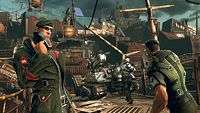 |
 |
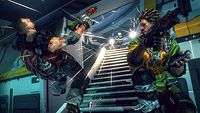 |
 |
 |
 |
As you mentioned earlier, the game allows you to control a persistent character but if you want to play as resistance in one game but security in another, would you use the same character or would you have multiple character slots?
You’re allowed to maintain up to sixteen characters. When you start your first one, you can level it up to level twenty which is important because there are dozens and dozens, sixty in our current build, of abilities and items but you can only have twenty of those to assign to your character so you could max out your operative and have a bunch of cool abilities but you’re not going to have a guy who’s the best engineer, operative, medic and soldier all at once. Once you’ve maxed out that guy you can sell abilities back and try new abilities, so we don’t restrict you arbitrarily in that way but we don’t want you to waste all the XP you’re earning so any XP you earn after that goes into a pot and you can roll a new character and start levelling him up with your additional XP up to a maximum of sixteen different characters so you can have your guy who’s, by default, a big body type maxed engineer with all the abilities that increase his supply charge rate, the supplies he can give, battle hardened and that’s how you feel like playing for twenty minutes. Of course you can change combat roles but the core character class is engineer. You might have your operative who’s skinny and has every ability that makes him agile, sprinting reload and grenade throwing, the ability to shoot grenades out of the air, all of that stuff that’s focused on being fast and agile and you might want to play as him so it’s really up to you. We’re not constraining and we’re not making many rules; the only rules we have relate to game play in the way that you’d need for two teams to have fun playing football.
 And finally, you mentioned that the single and multiplayer modes both work on the same principle; does that mean that mean that multiplayer will be a drop in and out experience so for example if you want to play multiplayer but no one’s around, you can just play single player until someone drops into your game?
And finally, you mentioned that the single and multiplayer modes both work on the same principle; does that mean that mean that multiplayer will be a drop in and out experience so for example if you want to play multiplayer but no one’s around, you can just play single player until someone drops into your game?
Yeah, totally. You don’t need to go into a lobby to start up, you just drop in and out in real time while you’re playing; your friend comes online, you just drop him an invite and he’ll join your game and you get started straight away.
Brink is set for release in Spring 2011 and I for one can’t wait to play it.
Last five articles by Iain
- Star Wars: The Old Republic - Hands On Preview
- BRINK - Review
- A New Beginning Preview
- The 'F' Word
- Working Class Hero
















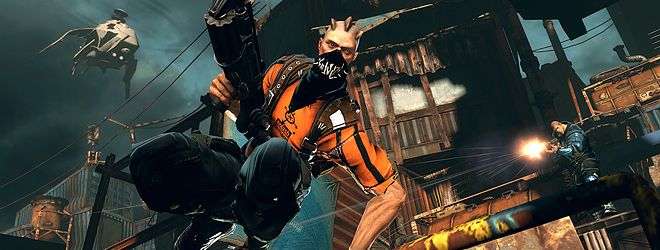
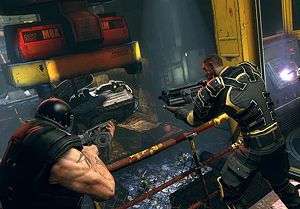


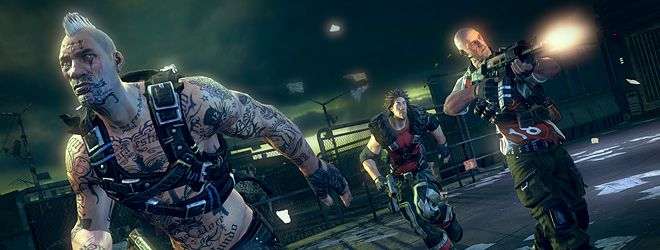





Brilliant man. Great interview and im with you, cant wait for Brink.
Brink was probabaly the game of Eurogamer for me, sheer awesome. great interview too
Looking forward to this, saw it last year at the EG Expo and again this year, looks brilliant!
Superb interview, Pix. Game has some interesting sounding features, though may be a bit shootery for me. Reminds me of Team Fortress in a way with elements of Mirror’s Edge. Concept and location are intruiging and the graphic style is impressive looking; I reckon this one will do well.
…meant to say that I wonder if this year’s Apprentice has a task that has them running some event or other at Eurogamer…don’t see Nick being seriously into trash talking on Modern Warfare, although you never know….his GamerTag may be SmackdownDeathLawyer or something.
Lorna, you’re a genius. On Friday there were some people trying to get people to download some shit app and the woman talking to me and Boss said it was going to be on telly. It never clicked at the time but that must be it!
Yeah it was the apprentice, one of the girls was in the paper I was reading on the train during the journey down
cool interview, I just put my pre order in after reading it. next year is so far away :’(
There were four games that made me want to go to Eurogamer, specifically. Fallout New Vegas, obviously, Hunted: Demon’s Forge, RAGE (I can’t wait to see that thing in action!) and Brink. I’m not in to shooters, as I’ve said countless times in the past, but I really fancied both RAGE and Brink even though they are predominantly “just shooters”. I have to say though, after reading this interview, I’m blown away by Brink. I love the idea that the body types affect the movement and feasibility of certain moves and I’m really keen to get my hands on the controller to try this Parkour stuff… Mirror’s Edge didn’t really appeal to me (probably from watching Lorna play it and hearing nothing but expletives!) but the mix of Parkour along with character levelling and various mission types where you actually have a choice of what character you play, really MASSIVELY appeals to me.
I was reading this last night, through near-shut eyes, thinking “damn, I wish I’d gone now”. I wished that anyway, but moreso now. Excellent interview by the way Iain, really enthusiastic responses – always a good sign!
Don’t mention Hunted: Demon’s Forge near Ed, Mark. He was less than impressed lol.
Yeah but Ed’s taste in games and mine are very far removed from each other
I saw a brief bit at Eurogamer and it looked alright but then the more I learnt about the “extras” and ways of getting XP, the more I was sucked in. I’m definitely interested!
Incredible interview!
Brink was certainly one of the best games at Eurogamer (it’d have been the best were it not for Zelda’s suprise appearance), and it should be nothing short of utterly fantastic.
Yeah, mentioning that game is probably not the best idea. I think Rob half wants to kill me for all the editing he has to do on the roundtable because of that.
Good interview Iain, nice one. I must admit, Brink does look very impressive. I’m not convinced yet, because I buy these online shooters and wind up not playing them much. But it does look impressive, so it’s a distinct possibility that I will cave on this.
[...] damage CEO, Paul Wedgwood said in an interview that he is not worried about alienating the ‘hardcore’ gamer with their S.M.A.R.T [...]
[...] Paul Wedgwood su Gaming Lives [...]
[...] For Iain of Gaminglives’ extensive interview with Paul Wedgwood about Brink at the Eurogamer … [...]
[...] wowed the crowds at last year’s Eurogamer expo and we were lucky enough to get the chance to chat to Paul Wedgwood about it. Combining single player, multiplayer, and co-op action, Brink will be released on May 20th (17th [...]